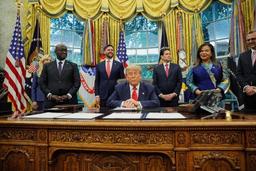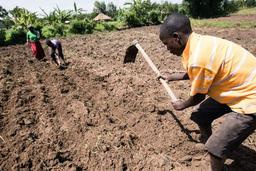Seychelles
Seychelles is a small island country in the Indian Ocean, northeast of Madagascar and about 1,600 km off the coast of East Africa. It consists of 115 islands, with Mahé being the largest and home to the capital, Victoria. Known for its stunning beaches, coral reefs, and unique wildlife, Seychelles relies heavily on tourism, fishing, and offshore finance. It has a population of around 100,000, making it Africa’s least populous independent nation, and its official languages are English, French, and Seychellois Creole. The country is a presidential republic and a member of the African Union.


0.1328 Million(2025)

East Africa (Kenya/Tanzania coast)

459 sq km

GMT+04:00

Seychellois Creole, English, French

Seychellois Rupee( SCR)

Christianity, Islam

Wavel Ramkalawan
Brief
Seychelles, an archipelago in the Indian Ocean, is located to the east of mainland Africa, northeast of Madagascar, and about 1,600 kilometers (1,000 miles) east of mainland Africa. The islands are known for their unique biodiversity and natural beauty. Historically, the islands were first discovered by the Portuguese in the 16th century, and later became a French colony in the 18th century. The British took control in the 19th century, and Seychelles remained a British colony until it gained independence in 1976.
Seychelles is a popular tourist destination, known for its pristine beaches, crystal-clear waters, and rare species of wildlife, including the giant Aldabra tortoise. The country's economy relies heavily on tourism, fishing, and agriculture. Its capital, Victoria, is located on Mahé Island and is the smallest capital city in Africa. The city is a hub for commerce, banking, and government administration.
Despite its small size, Seychelles has a rich cultural heritage influenced by African, French, Indian, and British elements. The country is a democratic republic with a stable government, and it has made significant progress in areas such as healthcare and education since gaining independence. Seychelles is also a member of various international organizations, including the United Nations and the African Union.
The country's beautiful environment, biodiversity, and friendly people make it a special and unique part of Africa.
Photos and Videos
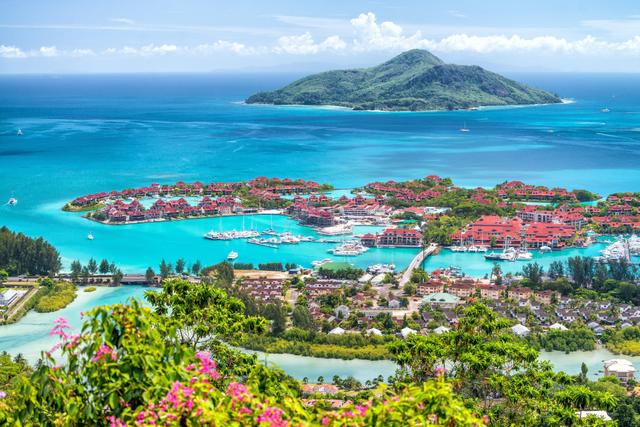



National anthem
Cultural Life
Cultural milieu
Seychelles has a rich, multicultural society shaped by African, European, and Asian influences. The dominant culture is Creole, blending traditions from African slaves, French settlers, British colonial administrators, and traders from India and China. This cultural fusion is evident in the islands’ music, dance, cuisine, and language.
Seychellois Creole (Kreol Seselwa) is widely spoken and is an important symbol of identity, while English and French are also official languages used in education and government. Festivals like Creole Festival, held every October, celebrate traditional music (such as moutya and sega), food, and crafts. Cuisine combines seafood, tropical produce, and spices, with dishes like grilled fish, coconut curries, and rice-based meals.
Religion, mainly Roman Catholicism, plays a central role in community life, alongside smaller Anglican, Hindu, Muslim, and Baha’i communities. Visual arts, storytelling, and folklore remain important forms of cultural expression. While Seychelles has modernized quickly, it still cherishes its Creole heritage and close-knit island traditions.
Daily life and social customs
Daily life in Seychelles is relaxed and closely tied to family, community, and the sea. Many Seychellois start their day early, often shopping at local markets for fresh fish, fruits, and vegetables. Meals are family-centered, with Creole dishes like grilled fish, curries, and rice forming the staples.
Social life often revolves around extended family networks, church activities, and community gatherings. Respect for elders is an important value, and hospitality is warmly extended to visitors. People greet each other with handshakes or friendly kisses on the cheek among close acquaintances.
Music and dance are central to celebrations, especially traditional moutya and sega, performed during festivals, weddings, and public holidays. Important events include Creole Festival, religious feasts, and Independence Day.
Dress is generally casual and suited to the tropical climate, though people wear more formal clothes for church, work, or ceremonies. In rural areas and outer islands, life moves at an even slower pace, with fishing, small-scale farming, and crafts as daily occupations.
Despite rapid tourism growth and modern conveniences, Seychellois still proudly maintain their Creole customs, language, and sense of community.




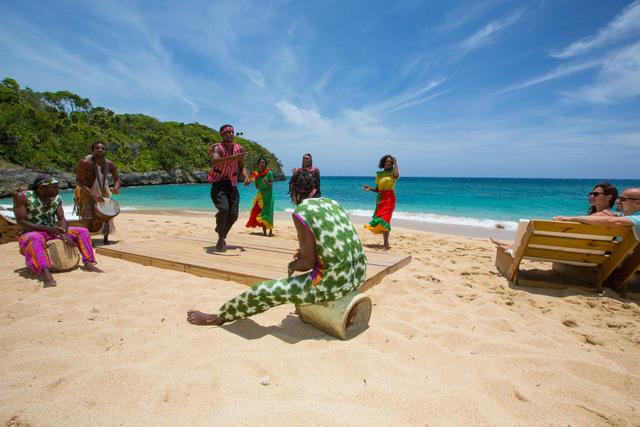
Cuisine
Seychelles’ cuisine is a flavourful blend of African, French, Indian, and Chinese influences, built around fresh seafood, tropical produce, and aromatic spices. Fish is the mainstay, served grilled, curried, or wrapped in banana leaves. Octopus curry (kari zourit), grilled red snapper, and salted fish are local favourites.
Staples include rice, breadfruit, lentils, and cassava, often accompanied by spicy chutneys and sambals. Coconut milk is widely used in sauces and desserts. Ladob, a sweet dish of ripe plantain and sweet potatoes simmered in coconut milk, is a popular treat.
Fresh tropical fruits like mangoes, papayas, bananas, and starfruit feature heavily in meals and snacks. Many Seychellois also enjoy Indian-inspired curries and Creole stews. Tea, fresh juices, and locally brewed palm wine are common drinks.
Overall, Seychellois cuisine reflects the islands’ multicultural heritage and abundant natural resources, offering simple but richly flavoured dishes.


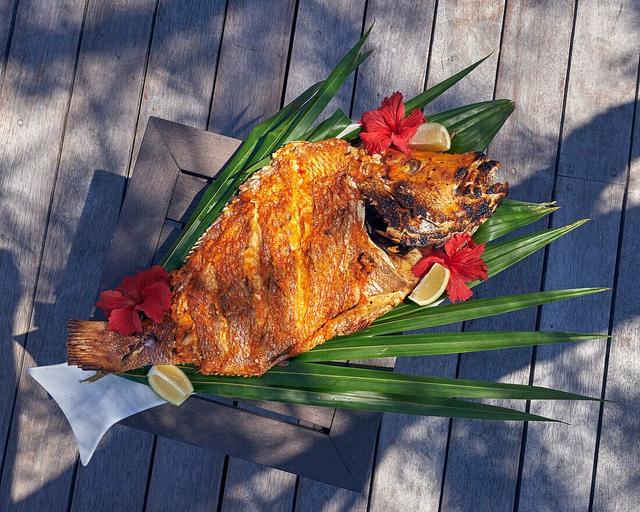

Music
Music in Seychelles is deeply tied to Creole culture, blending African rhythms, European melodies, and Asian influences. Traditional styles include moutya, a drumming and dance form rooted in the era of slavery, and sega, an upbeat dance music common across the Indian Ocean islands.
Instruments like drums, guitars, accordions, and banjos are often used, creating lively, rhythmic sounds. Songs are typically performed in Seychellois Creole and often tell stories about daily life, love, and the sea.
Modern Seychellois music incorporates reggae, zouk, and pop influences, while traditional dance and drumming remain important at festivals, weddings, and national celebrations such as Creole Festival.
Overall, music in Seychelles is an essential expression of identity, connecting people to their history and vibrant island spirit. In addition to traditional moutya and sega, gospel music is very popular in Seychelles, reflecting the country’s strong Christian (mainly Roman Catholic) heritage. Many Seychellois enjoy modern gospel styles, blending African rhythms, Caribbean influences, and Western contemporary gospel.

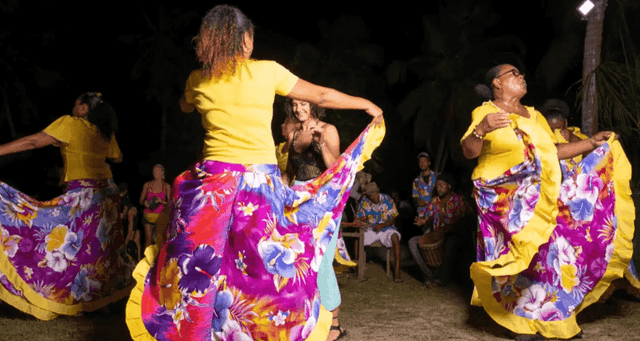


banjos
Gospel
Raggae
The arts
The arts in Seychelles are a vibrant reflection of the islands’ Creole heritage and multicultural influences. Visual arts include painting, sculpture, and crafts, often inspired by the lush natural environment, marine life, and traditional village scenes. Many local artists work with coconut shells, coral, wood, and recycled materials to create carvings, jewelry, and decorative items.
Traditional music and dance—especially moutya and sega—are central to cultural expression, performed at festivals and community events. Storytelling and folklore are also important, passing down legends and proverbs through generations.
Architecture showcases a blend of colonial French, British, and Creole styles, with colourful wooden houses, wide verandas, and steep roofs suited to the tropical climate.
In recent years, Seychelles has supported modern art galleries, cultural centres, and festivals, helping preserve its rich traditions while encouraging contemporary creativity. Overall, the arts remain a vital part of Seychellois identity and daily life.
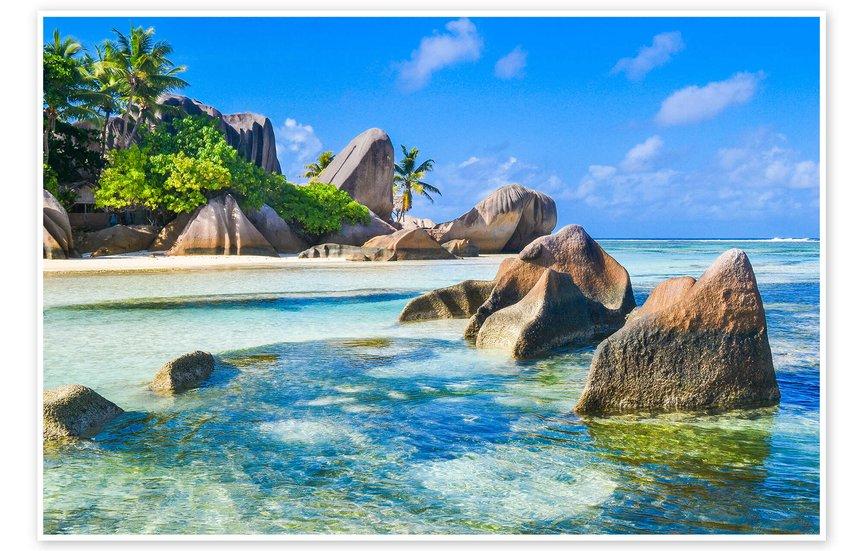



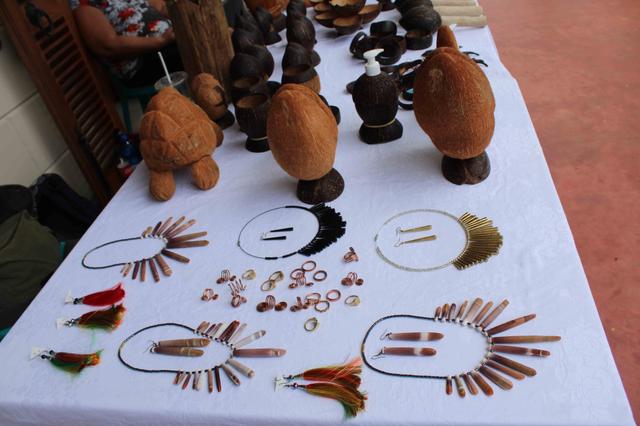
People
Ethnic groups
Seychelles is home to a mixed Creole population descended mainly from African slaves brought by French and British colonists, along with European settlers and traders from India and China. Over generations, these diverse roots blended to form the Seychellois Creole identity, which unites the vast majority of people today. This rich heritage is reflected in the islands’ language, cuisine, music, and customs, making Seychelles a unique multicultural society in the Indian Ocean. Minority groups include Hindus (2.1%) and Muslims (1.1%). The numerical majority Creoles are people of mixed African, Asian, Arabic and European ancestry. They make up 92 per cent of the population.
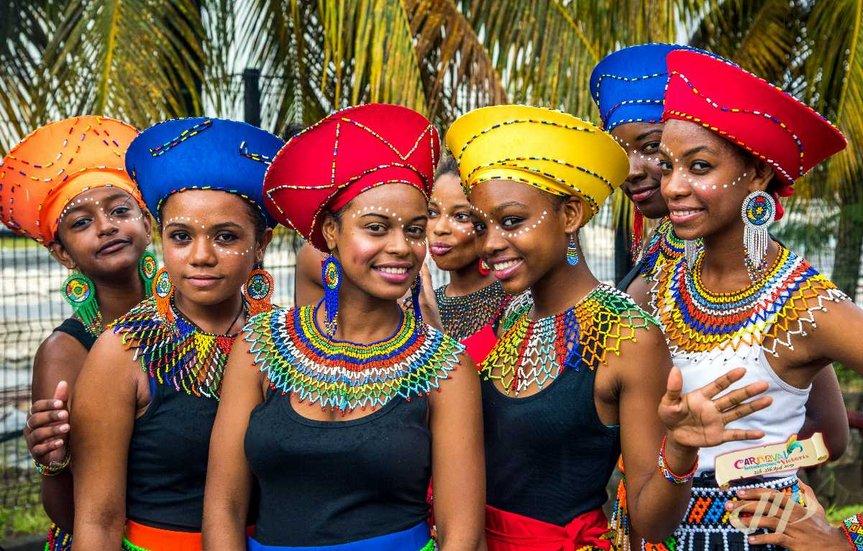




Religion
In Seychelles, most people are Christians, with about three-quarters of the population belonging to the Roman Catholic Church, a legacy of French colonial rule. Smaller groups include Anglicans, other Protestant denominations, Hindus, Muslims, and Baha’is. Religion is central to community life, with churches, mosques, and temples hosting regular services, festivals, and social gatherings. Many Seychellois also blend their faith with traditional beliefs, creating a unique spiritual culture that is woven into daily life across the islands.
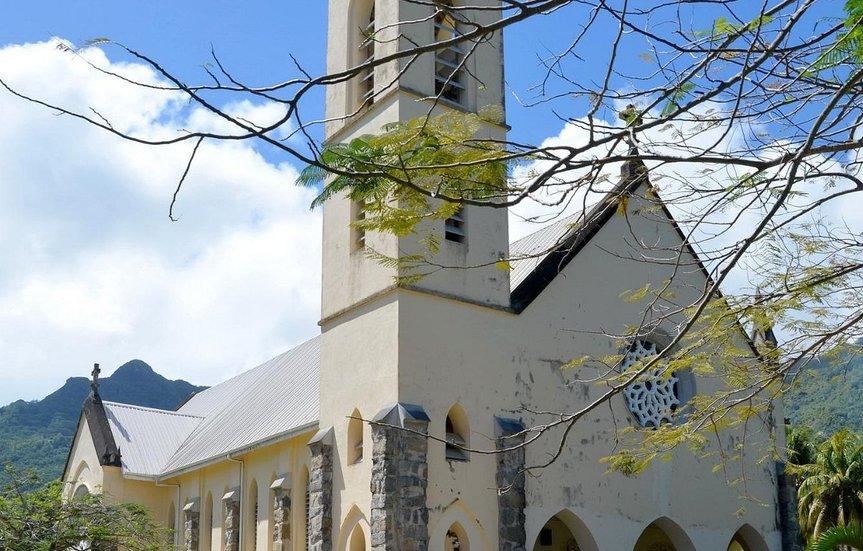
Settlement patterns
Settlement in Seychelles is mostly concentrated on the three main inner islands—Mahé, Praslin, and La Digue—with Mahé being home to about 90% of the population, including the capital city, Victoria. Communities are typically located along the coastal plains, where the land is flatter and more suitable for homes, roads, and agriculture. The interior, mountainous areas of the islands remain sparsely populated due to their steep terrain. Smaller, more remote outer islands are lightly inhabited or uninhabited, often used for tourism, research, or conservation.
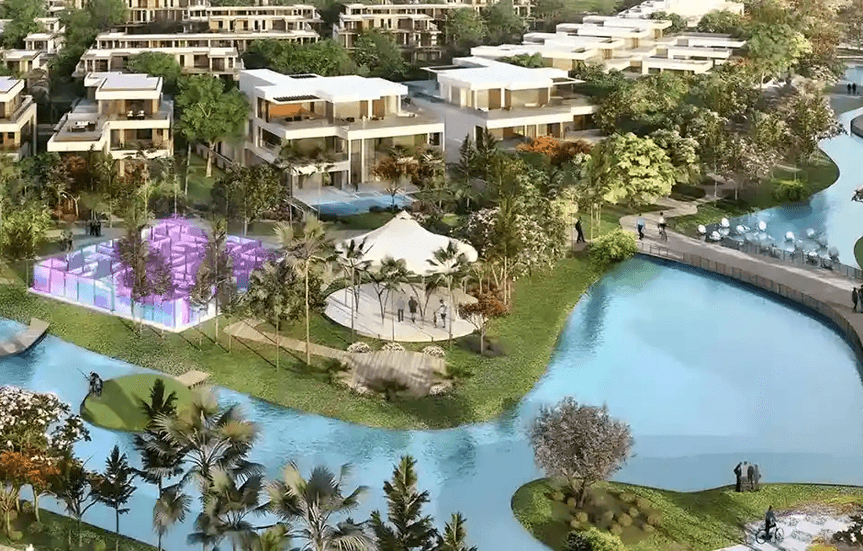
The coastal plains and lower mountain slopes of the main islands of Seychelles, especially Mahé, Praslin, and La Digue, contain the vast majority of the population and serve as centers of Creole culture. Traditional settlements are typically found along the shorelines or in sheltered valleys near rivers and fertile land. Houses, often built on stilts or raised foundations to protect against flooding and humidity, are constructed with timber, corrugated iron, and locally sourced materials. Level ground suitable for cultivation is limited, so small kitchen gardens and coconut or breadfruit groves are common around homes. The main subsistence crops include cassava, sweet potatoes, bananas, and tropical vegetables, while coconut palms and vanilla are important cash crops adapted to the humid, warm climate. Fishing is a vital supplement to agriculture, providing both food and income. In some outer islands, small communities engage in seasonal work, such as coconut processing or harvesting seabird eggs, often living in simple dwellings for part of the year. This combination of farming, fishing, and small-scale trade underpins the rural way of life in Seychelles.
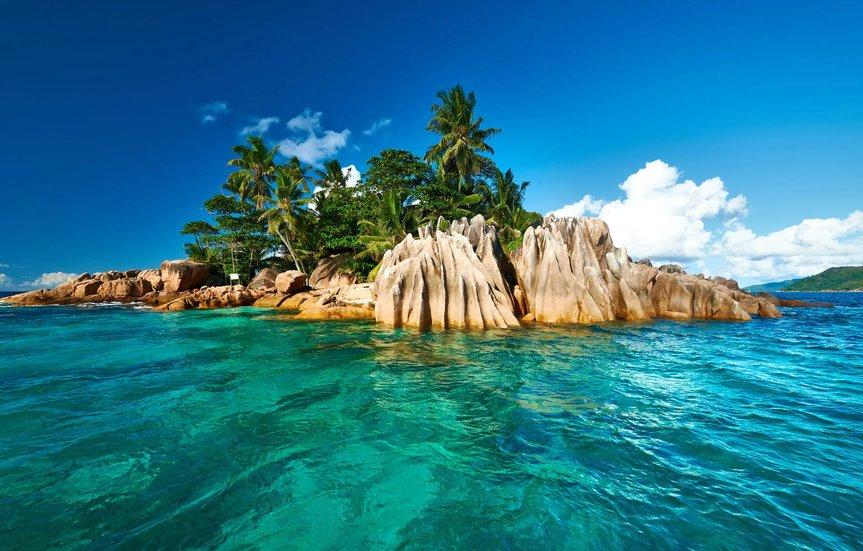
The interior, mountainous areas of Seychelles—especially on Mahé, the largest island—are dominated by steep granite peaks and dense tropical forests. These regions are largely undeveloped and sparsely populated, with much of the land protected as nature reserves and national parks, such as Morne Seychellois National Park. The rugged terrain and limited flat land make large-scale settlement or farming impractical, so only a few small villages or isolated houses are found along narrow valleys and forest edges. The highlands are home to rare endemic plants, orchids, palms, and unique wildlife, and serve as important watersheds that supply fresh water to coastal communities. Hiking trails and conservation projects are the main human activities in these interior zones, which remain some of the most pristine and biologically rich areas in the Indian Ocean.
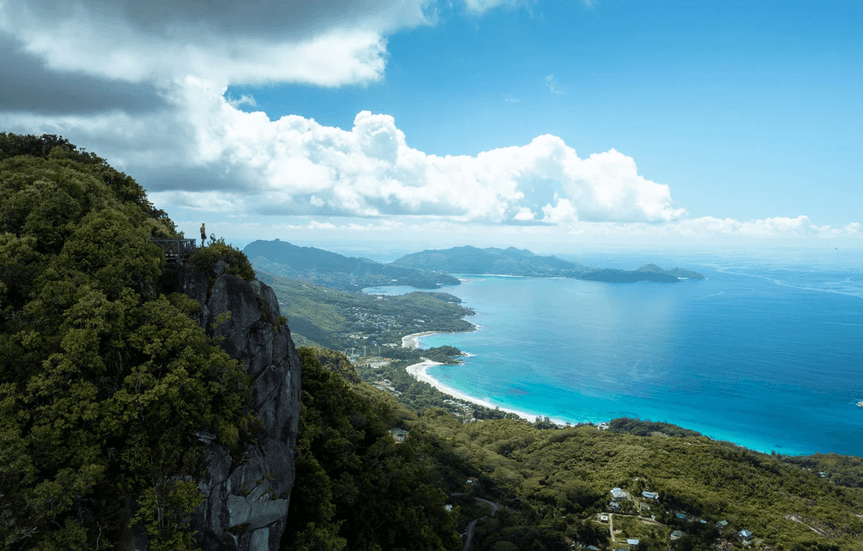
Urban settlement
Urban settlement in Seychelles is highly concentrated on Mahé, where the capital city, Victoria, serves as the main administrative, economic, and cultural center. Victoria is a small, compact city, home to the majority of government offices, schools, hospitals, shops, and businesses. Surrounding Victoria are suburban districts with residential neighborhoods, markets, and small industrial areas. Smaller urban settlements are found on Praslin and La Digue, where towns like Grand Anse and La Passe act as local hubs for tourism and services. Most urban areas are located close to the coast, taking advantage of flat land and port access, while the hilly interiors remain largely undeveloped. Overall, Seychelles’ urban settlement pattern reflects its small population, island geography, and reliance on coastal infrastructure.

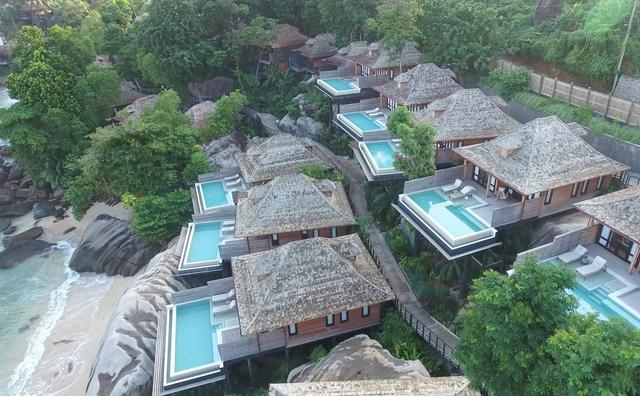

Demographic trends
Seychelles has a relatively small and steadily growing population of about 132,800, with a majority living in urban areas, particularly on Mahé Island. The country has a median age of around 34 years and a fertility rate of 2.1 children per woman, which is near replacement level. Life expectancy is high, averaging about 73 years, with women living longer than men. As fertility declines and longevity increases, Seychelles is experiencing a gradual aging of its population, a trend that may impact healthcare and social services in the coming years.
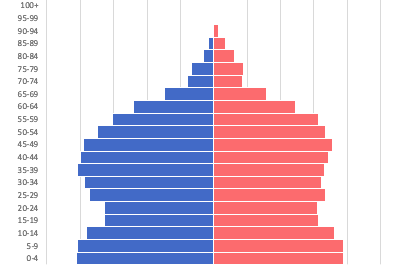
Touristic Cities
Victoria City
Victoria is the capital and largest city of the Seychelles, an archipelago nation in the Indian Ocean. It's located on the northeastern coast of Mahé Island, the largest island in the Seychelles. Victoria is the nation's commercial and cultural center, housing the only port and serving as the seat of government. Victoria, the capital of Seychelles, offers several attractions for tourists. Key highlights include the Seychelles National Botanical Gardens, the bustling Victoria Market, the historic Clock Tower, and the Arul Mihu Navasakthi Vinayagar Temple. Additionally, the city features the Sir Selwyn Selwyn-Clarke Market, St. Paul's Anglican Cathedral, and the Immaculate Conception, Victoria.




Anse Royale
Anse Royale is a coastal town located on the southeastern coast of Mahé, the largest island in Seychelles. It's known for its beautiful beach, calm waters, and vibrant marine life, making it a popular destination for swimming, snorkeling, and relaxing. The town also features historical sites, a local market, and lush tropical surroundings.


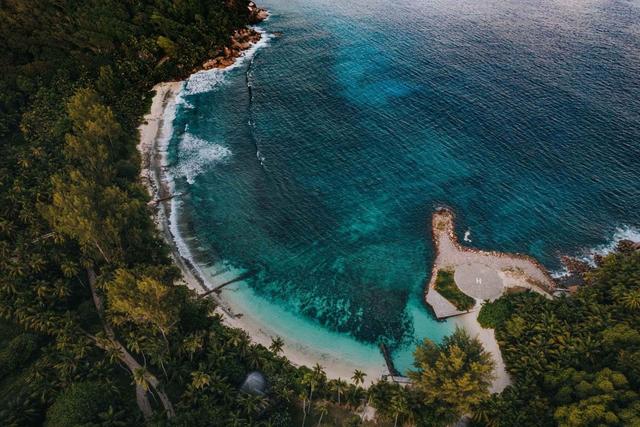

Beau Vallon
Beau Vallon is a popular beachside district located on the northwest coast of Mahé Island, Seychelles. It's known for its long, sandy beach, calm waters, and vibrant atmosphere, making it a favorite destination for tourists. The area offers a mix of relaxation and recreation, with various water sports, restaurants, and local food stalls.



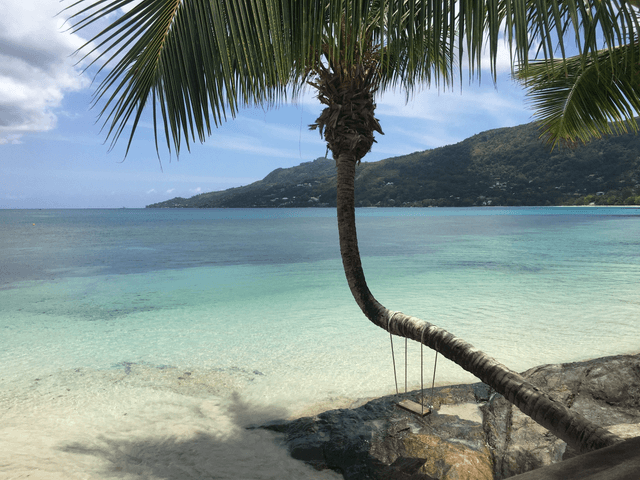
Grand Anse (Praslin)
Grand Anse (Praslin) is a district and a beach on Praslin Island, Seychelles. The district encompasses a large part of the island's southern and central areas, including the area around the airport and the long Grand Anse beach. It's known for its beautiful, wide beach, which is the longest on Praslin, and is popular for swimming and water sports.
Accomodation
Guest houses
Seychelles has many guest houses, often family-run, that offer an affordable and authentic alternative to big resorts. These guest houses range from simple, budget-friendly rooms to charming boutique accommodations. Most are located on Mahé, Praslin, and La Digue islands.
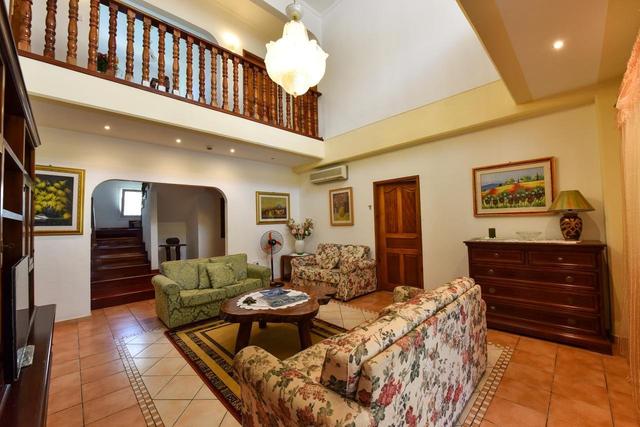

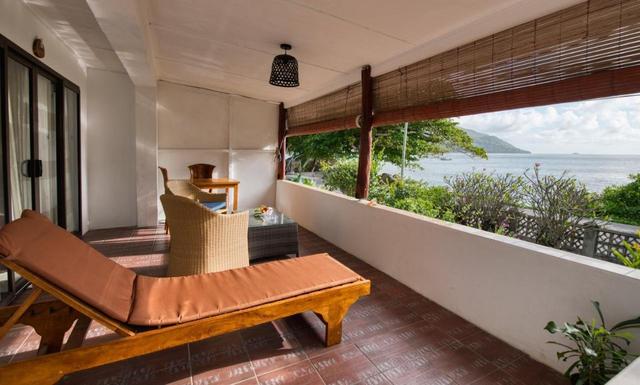
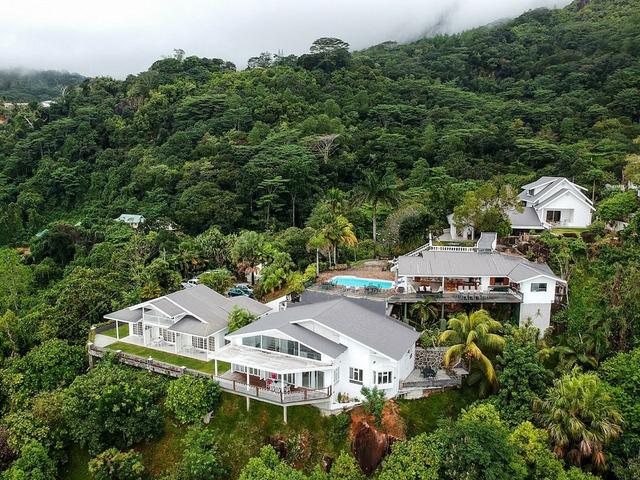
Hotels and resorts
Seychelles is renowned for its luxury hotels and resorts, many of which are set on pristine beaches or private islands. The country offers everything from ultra-exclusive five-star resorts with private villas, infinity pools, and fine dining (like North Island, Six Senses Zil Pasyon, and Four Seasons) to mid-range hotels and smaller boutique beachfront properties.
Most resorts are on Mahé (the main island), Praslin, and La Digue, with some located on more remote islands accessible only by boat or helicopter. Many high-end properties focus on seclusion, spa wellness, diving, and eco-friendly experiences.
Seychelles also has smaller hotels and guest houses that are more affordable while still offering great comfort and beach access.



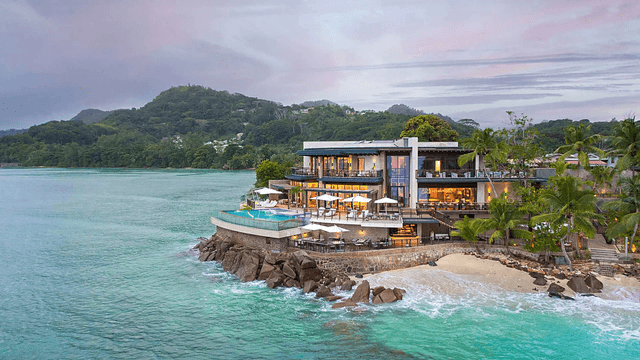
Riads
Seychelles does not have riads, because riads are a North African architectural tradition (traditional Moroccan houses built around an interior courtyard). The local architecture emphasizes Creole wooden houses, wide verandas, and open layouts facing the ocean or lush gardens.
Instead, most accommodation in Seychelles consists of Creole-inspired beach resorts, guest houses, villas, and boutique lodges set amid lush gardens or along the coast.
However, some luxury resorts and boutique hotels incorporate design elements reminiscent of riads, such as central courtyards, arched verandas, and shaded patios that evoke a similar sense of seclusion and tranquility, blending North African and Creole influences in their architecture. Overall, though, Seychelles accommodations are best known for open layouts facing the ocean, wooden verandas, and airy spaces rather than the classic enclosed riad design.



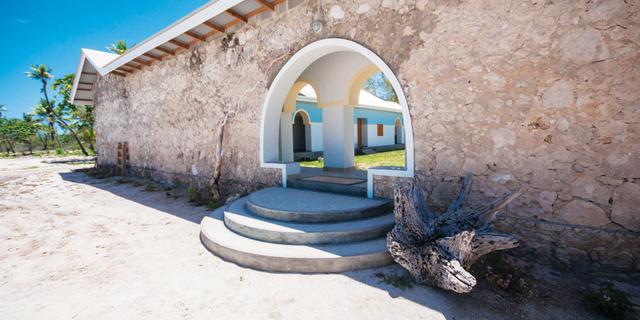
Campings
Camping in Seychelles is not widely developed like in some other countries, due to environmental protection laws and the country's focus on high-end eco-tourism.
However, there are limited options for rustic, nature-based stays, especially on less-developed islands or private eco-lodges that offer tented camps or nature chalets in forested or coastal settings. These are often part of eco-resorts or guest houses rather than public campgrounds.
Wild camping is prohibited, especially in nature reserves and protected marine parks, to preserve biodiversity.
Travelers seeking a camping-style experience in Seychelles usually stay in simple, affordable bungalows or guest houses that offer close contact with nature, often near beaches or national parks.



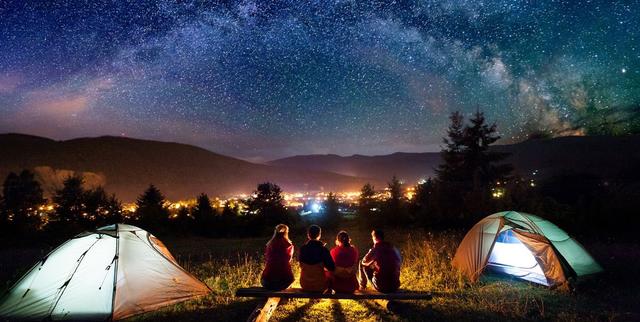
Requirements for Visa
Documents to be submitted for your application
- Valid passport
- Completed visa application form
- Proof of accommodation
- Return or onward travel ticket
- Proof of sufficient funds for the duration of your stay
- Travel health insurance
At the time of visa issuance, please provide the following documents
1.Original valid passport
2. Visa approval letter
3. Proof of accommodation
4.Return or onward ticket
5. Proof of sufficient funds
6.Travel health insurance
7. Any additional health document8.Visa application receipt
Useful links
- Official Seychelles Travel Authorization System
- Entry & Visitor’s Permit Details
- Convenient Reference & Guidance
- Immigration Authority
– Visa Policy of Seychelles
Economy of Seychelles
Agriculture, forestry, and fishing
Agriculture, forestry, and fishing in Seychelles are relatively small sectors due to the islands’ limited arable land, fragile ecosystems, and heavy reliance on imports. Agriculture focuses mainly on coconuts, cinnamon, vanilla, tropical fruits, and some vegetables for local consumption, with government efforts encouraging more food self-sufficiency. Forestry plays a minor role, largely restricted to sustainable management of forest reserves and conservation of endemic species. Fishing, especially tuna fishing, is the most important of the three, serving as a major pillar of the economy through artisanal and industrial operations, exports, and foreign-licensed vessels using Seychelles as a base. The government regulates these activities closely to balance economic benefits with the protection of marine and terrestrial biodiversity.

Resources and power
Seychelles has limited natural resources and relies heavily on imports to meet its energy and material needs. The country does not have significant mineral or fossil fuel deposits, so petroleum products are all imported mainly for electricity generation and transport. Most power comes from diesel-powered generators, though the government is investing in renewable energy, particularly solar, to diversify supply and reduce dependency on fuel imports. Freshwater resources are also limited, with rainfall and desalination plants providing most of the potable water. The surrounding ocean is Seychelles’ most valuable natural resource, supporting fisheries, tourism, and marine biodiversity, which are essential to the country’s economy and environmental sustainability.
Manufacturing
Manufacturing in Seychelles is a small yet vital component of the economy, contributing approximately 5–6% of GDP in recent years, equivalent to about US $120 million in output. The sector is dominated by resource-based, low- and medium-technology production, with food and beverage processing—especially fish canning (notably tuna)—accounting for most of its activity. Other modest manufacturing segments include beverages (beer, spirits), cigarettes, coconut and essential oils, paints, building materials, and small-scale crafts or orthopaedic appliances. Industrial output peaked around 2000 at nearly 18% of GDP but has since declined and stabilized around 5–6%, mirroring the island nation’s reliance on imports for most inputs—a factor that keeps production costs high and limits export competitiveness. Nonetheless, canned tuna remains the country’s strongest manufacturing export, making up over 90% of its manufactured exports, while the government’s recent industrial policy targets higher-value green and niche products—such as marine biotechnology, cosmetics, and technology—to diversify and boost economic resilience.
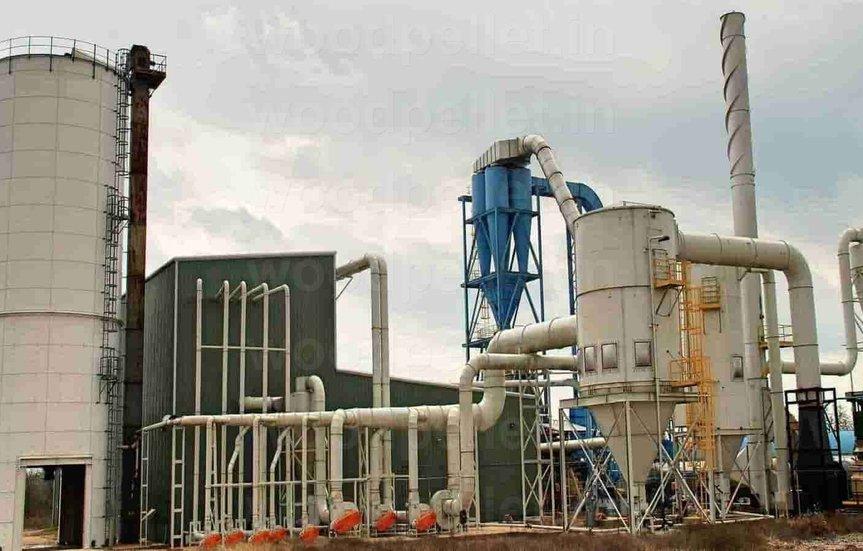
Finance
Seychelles has a bank-dominated financial system, with total banking assets exceeding 100% of GDP, and the top three banks (two foreign-owned subsidiaries and one state-owned) holding around 80–86% of sector assets and deposits. In 2023, domestic credit to the private sector stood at about 32% of GDP, notably lower than global averages, though it represents recovery from pandemic lows. Meanwhile, bank credit rose to around 32–34% of GDP, up from about 30%.
The Central Bank holds the reins on monetary policy, setting key interest rates (1.75–2%) and maintaining solid capital adequacy (around 20%), although non-performing loans (around 7–8%) remain a concern, particularly debt tied to tourism. The system also faces significant dollarization, with about 42–50% of assets and 52% of deposits in foreign currency. As of 2021, deposits totaled over 110% of GDP, highlighting strong domestic saving and liquidity.
On the non-bank financial front, the Financial Services Authority oversees insurance, capital markets, trusts, foundations, and offshore financial activities, reflecting Seychelles’ role as a growing offshore financial center. The country is also a pioneer in sustainable financing, issuing the world’s first Sovereign Blue Bond (US $15 million, 6.5% coupon) in 2018 to fund marine conservation and bolster blue economy initiatives.
Overall, while well-capitalized and liquid, Seychelles’ finance sector is concentrated and less diversified, with limited private sector credit, moderate dollarization, and still-developing non-bank markets. Ongoing regulatory reforms, including Basel III implementation and new bank resolution frameworks, aim to strengthen financial stability and deepen the market.

Trade
Trade in Seychelles is marked by a substantial trade deficit, as the island nation relies heavily on imports for food, fuel, machinery, and other essentials, while exporting primarily fish products—particularly tuna—and tourism-related services. The country benefits from preferential trade agreements with the European Union and Group of African, Caribbean and Pacific States (ACP), and actively participates in regional trade initiatives through the Common Market for Eastern and Southern Africa (COMESA) and the Indian Ocean Commission. The Port of Victoria serves as the central hub for maritime trade, efficiently handling cargo transshipments and bulk inflows. Despite infrastructural and logistical challenges, the government has prioritized trade diversification—promoting value-added processing of fisheries, horticulture, and niche exports such as coconut oil and crafts—to improve export earnings and reduce dependency on imports. Seychelles' economy is heavily reliant on tourism and fisheries, with the latter contributing over 90% of total exports. The country's main trading partners include France, the United Kingdom, and Saudi Arabia. Due to limited natural resources, Seychelles imports a significant amount of petroleum products.

Labour and taxation
Seychelles' labor market is characterized by a small, skilled workforce. The unemployment rate has been relatively low, typically ranging between 2% and 4%, indicating a high level of employment. However, the country faces challenges such as skills mismatches, youth unemployment, and a dependence on foreign labor in certain sectors like construction and hospitality. Employment income of individuals is subject to income tax at the following rates for citizens: income up to SCR (Seychelles rupee) 8 555,5 per month – 0%; from SCR 8 555,5 to 10 000 per month – 15%; from SCR 10 000 to 83 000 per month – 20%.

Transportation and telecommunications
Seychelles has a well-developed transportation system despite being an archipelago. It includes a network of roads, primarily on Mahé and Praslin, with limited public transportation options. Ferry services connect the main islands, and Air Seychelles provides domestic and international flights. Telecommunications infrastructure is also advanced, with high cellular phone usage and good global connectivity. Seychelles has a network of paved roads, mainly on Mahé and Praslin. Ferry services are crucial for inter-island travel, connecting Mahé, Praslin, and La Digue. Seychelles International Airport on Mahé is the main airport, with Air Seychelles providing domestic and international flights. Some smaller islands may have limited or no roads, with walking or bicycles being the primary modes of transport. Mobile Phones: Seychelles has a high rate of mobile phone usage, among the highest in sub-Saharan Africa. Internet access is widely available, with high internet penetration rates.
Latest News in Seychelles
Politics
The first president of independent Namibia, Sam Nujoma, has died at the age of 95 in the capital Windhoek, the country's current leader has announced.
Politics
Ugandan President Yoweri Museveni has officially announced his intention to seek re-election in the 2026 presidential race, extending his nearly four-decade rule. Museveni, who has been in power since 1986, is once again positioning himself as the steady hand guiding Uganda through challenges. His decision has sparked mixed reactions, with supporters praising his leadership and longevity, while critics call for fresh leadership and political reform. As the nation looks ahead to the 2026 elections, Uganda braces for a heated political contest.
Politics
Peace Agreement with DRC Rwanda and the Democratic Republic of Congo (DRC) signed a U.S.-brokered peace deal aimed at ending conflict and promoting regional trade. Rwanda agreed to stop supporting armed groups like M23 rebels, though it denies involvement. Tensions remain, and President Kagame is cautious about whether the peace will last.
Wildlife
Tanzania has announced that all foreign tourists visiting Mainland Tanzania will be required to purchase a mandatory travel insurance policy upon arrival, beginning January 2026. The new regulation, issued by the Ministry of Finance on July 4, 2025, is part of the government reforms in the country’s 2025/26 financial year agenda. According to the notice, the measure will apply to all non-citizens, with the exception of visitors from countries that are part of the East African Community (EAC) and the Southern African Development Community (SADC). Citizens from these regions will continue to be exempt from the requirement.
Environment
In light of the growing food insecurity crisis across many African nations, heads of state and agriculture experts gathered in Nairobi, Kenya, this week to discuss solutions to address food shortages, especially in regions severely affected by climate change, political instability, and economic challenges. The two-day summit, titled “Agriculture and Climate Resilience: A Pan-African Strategy”, brought together government officials, NGOs, scientists, and international organizations to create a comprehensive strategy to improve agriculture, nutrition, and sustainable food systems across the continent.
Tech & Science
In 2025, Artificial Intelligence (AI) isn’t just a futuristic buzzword - it’s the secret weapon behind some of the world’s most successful content creators. From bloggers and YouTubers to podcasters and marketers, AI-powered tools are changing the way we brainstorm, write, design, and edit. If you've ever struggled with writer’s block, lacked design skills, or wished for faster content creation - AI might be your best assistant yet. Here’s how AI is revolutionizing the creative industry and how you can use it to boost your projects.


